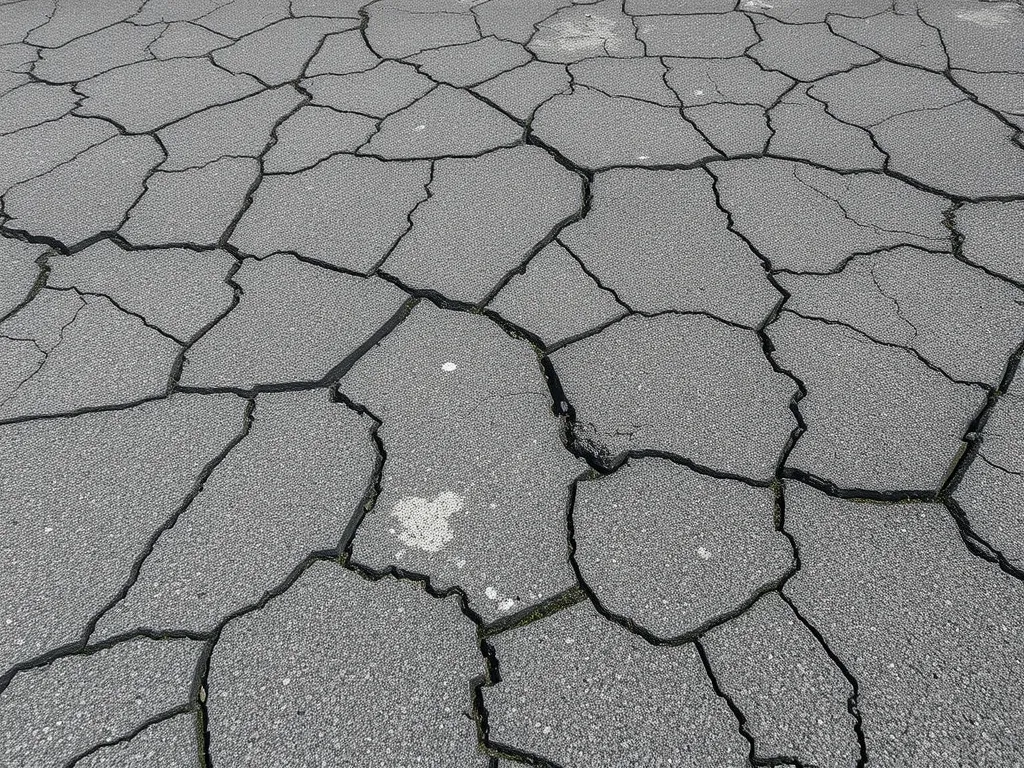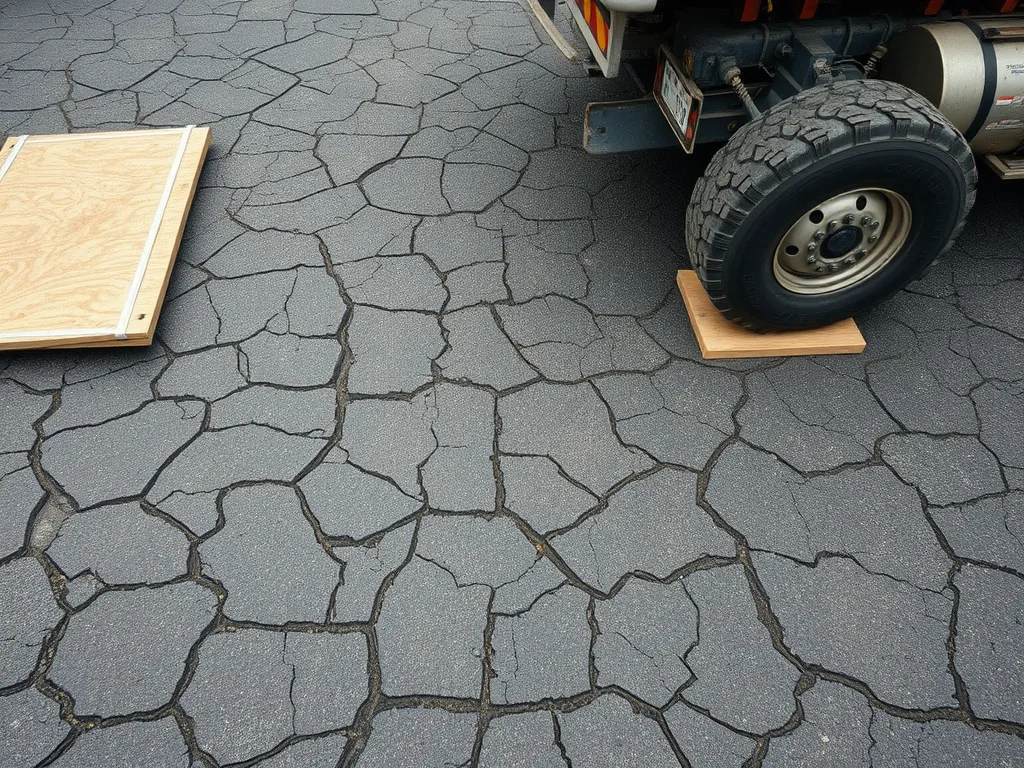Common Causes Of Asphalt Cracks
Published on: October 18, 2025 | Last Updated: April 14, 2025
Written By: George Voss
Asphalt cracks form due to environmental stress, structural pressure, and installation errors. These fractures develop when UV rays harden the surface, heavy vehicles exceed weight limits, or crews skimp on proper compaction. Recognizing crack patterns early helps prevent costly repairs and extends pavement life up to 10-15 years.
This guide breaks down why asphalt fails. Learn how weather cycles create freeze-thaw damage, why soil quality matters under pavement, and how sealcoating gaps accelerate wear. We’ll explain crack types from hairline splits to alligator patterns, plus repair methods like infrared patching that bond fresh asphalt at 300°F.
Contents
Introduction to Asphalt Pavement Cracking
Asphalt pavement cracking occurs when stress exceeds the material’s strength. While asphalt mixes use aggregates and bitumen binders for flexibility, daily wear breaks down these components. Temperature swings, traffic loads, and ground movement create tension that leads to visible surface damage over months or years.
Why Asphalt Develops Cracks Over Time
Asphalt degrades due to three primary factors: material limits, environmental stress, and structural strain. UV exposure breaks down bitumen binders, making surfaces brittle. Water seeps into tiny voids, expanding during freezing temperatures. Heavy trucks apply pressure that weakens layers beneath the pavement. Even well-built asphalt loses 40% of its stiffness after 7-10 years without maintenance.
- Material Limits: Bitumen becomes less flexible with age
- Environmental Stress: Thermal contraction/expansion cycles
- Structural Strain: Repeated traffic loads exceeding design capacity
The Importance Of Early Crack Identification
Catching cracks under ¼ inch wide prevents costly repairs. Unsealed hairline fractures let water penetrate the base layer, causing potholes or alligator cracking. A single unsealed crack can spread 300% wider within two freeze-thaw cycles. Regular inspections spot issues before they compromise structural integrity.
Infrared scans detect subsurface voids with 90% accuracy, while sealcoating fresh cracks reduces water infiltration by 70%. Addressing edge cracks within 6 months extends pavement life by 3-5 years compared to neglected surfaces.
Spotting early warning signs prepares property owners to tackle root causes. Next, we’ll break down the main culprits behind pavement failures—from climate impacts to construction flaws.
Primary Causes Of Asphalt Cracks
Asphalt pavement cracking stems from three core issues: environmental wear, structural strain, and construction flaws. Recognizing these triggers helps property owners address problems before they escalate.
Environmental Factors
Weather and climate directly impact asphalt’s lifespan. Extreme temperatures, moisture, and sunlight degrade pavements faster than routine traffic wear.
UV Radiation and Asphalt Oxidation
Sunlight breaks down bitumen binders through oxidation. Over 2-5 years, unsealed surfaces lose flexibility, becoming brittle. This creates spiderweb-like asphalt surface cracks measuring 1/8″ to 1/4″ wide.
Freeze-Thaw Cycle Damage
Water seeps into tiny cracks in asphalt pavement during thaws. When temperatures drop below 32°F, it expands by 9%, widening gaps. Repeated cycles cause alligator cracking and potholes.
Rainwater Infiltration and Drainage Issues
Pooled water weakens sublayers. Without proper slope (1-2% minimum) or clogged drains, hydrostatic pressure lifts asphalt layers. This leads to edge cracks on driveways and structural failures.
Structural Stressors
Excessive weight and unstable bases strain pavements beyond design limits. These issues account for 40% of premature asphalt cracks in commercial lots.
Heavy Vehicle Traffic and Overloading
Trucks exceeding 18,000 lbs per axle exert 8x more force than passenger cars. Repeated stress creates ruts and transverse cracks perpendicular to traffic flow.
Subgrade Settlement and Soil Instability
Poorly compacted soil shifts under pavement layers. Clay-rich soils swell when wet, causing block cracking. Sandy soils erode, leading to sinkholes and alligator patterns.
Installation & Maintenance Shortcomings
Up to 30% of asphalt cracks trace back to paving errors or neglected upkeep. Quality control during installation prevents most issues.
Poor Compaction During Paving
Asphalt mix cooled below 220°F before compaction leaves air pockets. These weak zones develop longitudinal cracks within 12 months.
Inadequate Asphalt Thickness
Driveways under 2.5″ or roads under 3″ crumble under standard loads. Thin sections show fatigue cracks faster, needing repairs 50% sooner.
Lack of Preventative Sealcoating
Unsealed asphalt absorbs 3x more water. Applying coal-tar emulsion every 3 years cuts crack formation by 60% and extends pavement life 8-10 years.
Recognizing why cracks form guides effective repairs. Next, we’ll break down crack types and their specific warning signs.

Types Of Asphalt Cracks
Asphalt surface cracks reveal critical information about pavement health. Different crack patterns indicate specific stress types – from weather effects to structural failures. Let’s break down common asphalt crack types and their root causes.
Surface-level Cracking
Thin fissures under 1/4″ wide often start as cosmetic issues but allow water penetration. Two primary forms dominate this category.
Longitudinal Cracks (Parallel to Pavement Lines)
These asphalt lines form along the pavement’s length, typically from poor joint construction or repeated traffic loads. Heavy trucks exceeding 18,000 lbs per axle accelerate this cracking in asphalt pavement through constant lateral pressure.
Transverse Cracks (Perpendicular to Pavement Lines)
Thermal contraction during temperature drops below 40°F creates these evenly spaced cracks. Asphalt binder becomes brittle when oxidized, cracking every 20-30 feet across lanes. Northern states see 30% more transverse cracks than southern regions.
Structural Failure Cracks
Interconnected cracks signal deeper base failures. These asphalt pavement cracking patterns require immediate attention to prevent costly repairs.
Alligator/Map Cracking Patterns
Resembling reptile skin, this web of cracks indicates compromised subbase layers. Poor drainage (slopes under 2%) or insufficient asphalt thickness (less than 3″ for driveways) are prime culprits. Load-bearing areas show these patterns first.
Block Cracking in Aging Asphalt
Large rectangular sections (1-10 sq ft) form when asphalt binder loses 60%+ flexibility. Pavements over 15 years old typically develop block cracks through normal oxidation. Low-VOC sealcoating every 3 years delays this degradation.
Edge Cracking on Driveways
Asphalt cracks on driveway edges appear within 2 feet of borders. Ignored edge cracks can spread 6-12 inches annually inward.
Root Intrusion from Nearby Vegetation
Tree roots within 20 feet exert 50-200 psi pressure on pavement edges. Silver maples and poplars cause 80% of root-related asphalt cracks on residential properties.
Shoulder Erosion Issues
Unsupported pavement edges lose 1/2″ base material yearly from poor drainage. Gravel shoulders without proper crowning erode fastest, creating 2-4″ gaps that collapse under vehicle tires.
Recognizing these asphalt crack types helps target repairs effectively. Now let’s explore how to stop cracks from forming in the first place.
Also See: Asphalt Repair Warranties: What You Should Know
Asphalt Crack Prevention Strategies
Stop cracks before they start with these proven methods. Focus on water control, surface shields, and smart load plans.
Proper Drainage System Maintenance
Water causes 80% of asphalt cracks. Keep drains clear with these steps:
- Clean catch basins monthly during fall
- Check slope grades (2% min) yearly
- Fix pooled water spots within 48 hours
Use French drains or trench channels near edges. Soil with 15% clay needs extra gravel layers to stop seepage.
Regular Sealcoating Schedules
Sealcoats block UV rays and water. Apply every 24-36 months using coal-tar or asphalt-based mixes. Key benefits:
- Fills hairline cracks up to 1/8″ wide
- Cuts oxidation by 70%
- Costs $0.14-$0.25 per sq ft
Use PG binders (performance-graded asphalt) in hot climates. For driveways, pick sealants with silica sand for grip.
Weight Distribution Best Practices
Heavy loads crack asphalt faster than age. Spread weight with:
- Steel plates under jack stands
- 3/4″ plywood sheets for truck tires
- Geogrid mats in high-traffic zones
Limit truck axle loads to 10,000 lbs on residential pavements. Reinforce edges with 6″ crushed stone where cars turn.
While prevention helps, existing damage needs quick fixes. Let’s explore repair options for cracked asphalt surfaces.

Repairing Cracked Surfaces
Timely interventions stop minor fractures from becoming costly failures. Effective repair methods vary based on crack width, depth, and location within paved surfaces.
DIY Crack Filling Techniques
Homeowners can fix surface-level splits under ½” wide using store-bought materials. Begin by clearing debris with wire brushes or compressed air. Apply sealant using pour pots or caulk guns for precise control.
Choosing Sealers
Rubberized compounds flex with temperature shifts, resisting rebonding failures. Look for PG-graded products meeting Performance Grade standards – PG 64-22 handles most climates. Avoid cheap coal-tar emulsions; they shrink more than 15% during curing.
Hot Pour vs Cold Pour
Hot-applied sealants melt at 350°F, bonding tightly to vertical crack walls. Ideal for busy roads or splits wider than ¼”. Cold mixes work for driveways under ¾” wide – simply pour straight from the bucket. Expect hot methods to last 3-5 years versus 1-3 years for cold.
Professional Repairs
Contractors tackle structural damage using specialized gear. Thermal imaging scans often reveal hidden voids beneath visible splits before work begins.
Infrared Methods
Heating elements soften existing pavement to 300°F, blending fresh mix seamlessly into aged material. Fixes areas up to 50 sq.ft. for $2-$4 per square foot. Eliminates cold joints that invite moisture intrusion.
Full-Depth Patching
Removes compromised layers down to the subbase when splits exceed 2″ deep. Compacted stone bases get topped with virgin Superpave mix containing polymer-modified binders. Costs $8-$15 per square foot but prevents recurring splits in high-traffic zones.
While proper repairs extend pavement life, climate plays the defining role in long-term outcomes – let’s explore regional impacts next.
Regional Considerations for Asphalt Damage
Local climate and geography directly impact how asphalt cracks form and spread. Let’s examine two extreme environments shaping pavement performance.
Climate-specific Challenges
From desert heat to ocean spray, weather patterns dictate crack formation. Pavement engineers adjust mix designs and maintenance plans based on these regional threats.
Asphalt Cracking in California’s Dry Heat
California’s Central Valley sees 100°F+ temperatures frying asphalt surfaces. Prolonged UV exposure accelerates oxidation, turning flexible pavement brittle. Thermal stress from daily 40°F swings causes block cracking – rectangular fractures splitting pavement into segments.
Palm Springs and Fresno roads often need PG 64-10 binders with higher temperature grades. Modified asphalt mixes with SBS polymers resist thermal cracking 35% longer than standard hot-mix. Annual sealcoating cuts crack formation rates by half in these zones.
Coastal Area Moisture Damage
Saltwater corrosion plagues Atlantic and Gulf Coast pavements. Humidity keeps asphalt constantly damp, while storm surges drive salt into surface pores. This combination triggers edge cracks and alligator cracking within 2-3 years of installation.
Charleston and Miami contractors combat this with 3/4″ thick polymer-modified sealants. Proper drainage slopes (2% minimum) prevent water pooling – a key factor in 78% of coastal asphalt failures. Freeze-thaw cycles in Pacific Northwest coastal zones worsen existing cracks through repeated expansion.
While regional factors influence crack patterns, installation quality remains the foundation of pavement durability. Next, we’ll explore how proper construction techniques prevent early failures.

FAQs About Asphalt Cracks
Are Driveway Cracks Normal in Older Asphalt?
Yes, driveway cracks are common in older asphalt due to prolonged exposure to environmental factors and wear over time. Regular maintenance can help extend the life of the driveway and minimize serious damage.
Map Vs Alligator Cracking: Key Differences
Map cracking appears as a network of interconnected cracks resembling a map, typically indicating excessive drying or aging. In contrast, alligator cracking resembles the skin of an alligator, indicating severe structural issues often caused by heavy loads and insufficient base support.
How Long Before New Asphalt Develops Cracks?
New asphalt can develop cracks within a few years, especially if not properly maintained. Factors like environmental exposure, load stress, and the quality of the installation can influence the timeline for crack development.
Effectiveness Of Asphalt Crack Fillers
Asphalt crack fillers can be very effective in preventing further damage when applied correctly. They work by sealing cracks and preventing water infiltration, which can cause more extensive damage if left untreated. However, the longevity of the filling depends on the product used and the existing conditions of the asphalt.
Closing Thoughts
Asphalt cracks are a common issue for driveways and roads, often stemming from various environmental factors, structural stressors, and installation shortcomings. Recognizing the primary causes and types of cracks is vital for effective preventative measures and repairs. Regular maintenance, including proper drainage solutions and sealcoating, can significantly extend the lifespan of asphalt surfaces.
Whether managing residential or commercial pavements, understanding these common causes helps in making informed decisions on repairs and maintenance. For more detailed guidance and resources, visit Asphalt Calculator USA.
Additional Resources for You:
- Lavin, P. (2003). Asphalt Pavements: A Practical Guide to Design, Production, and Maintenance for Engineers and Architects. London: Taylor & Francis.
- The 6 Main Causes Of Asphalt Cracking | NK
- Top Causes of Cracks in Asphalt Pavement
- 7 Types of Asphalt Cracking and Their Causes – Superior Aggregates
- The Most Common Reasons for Asphalt Cracking – EverLine Coatings


